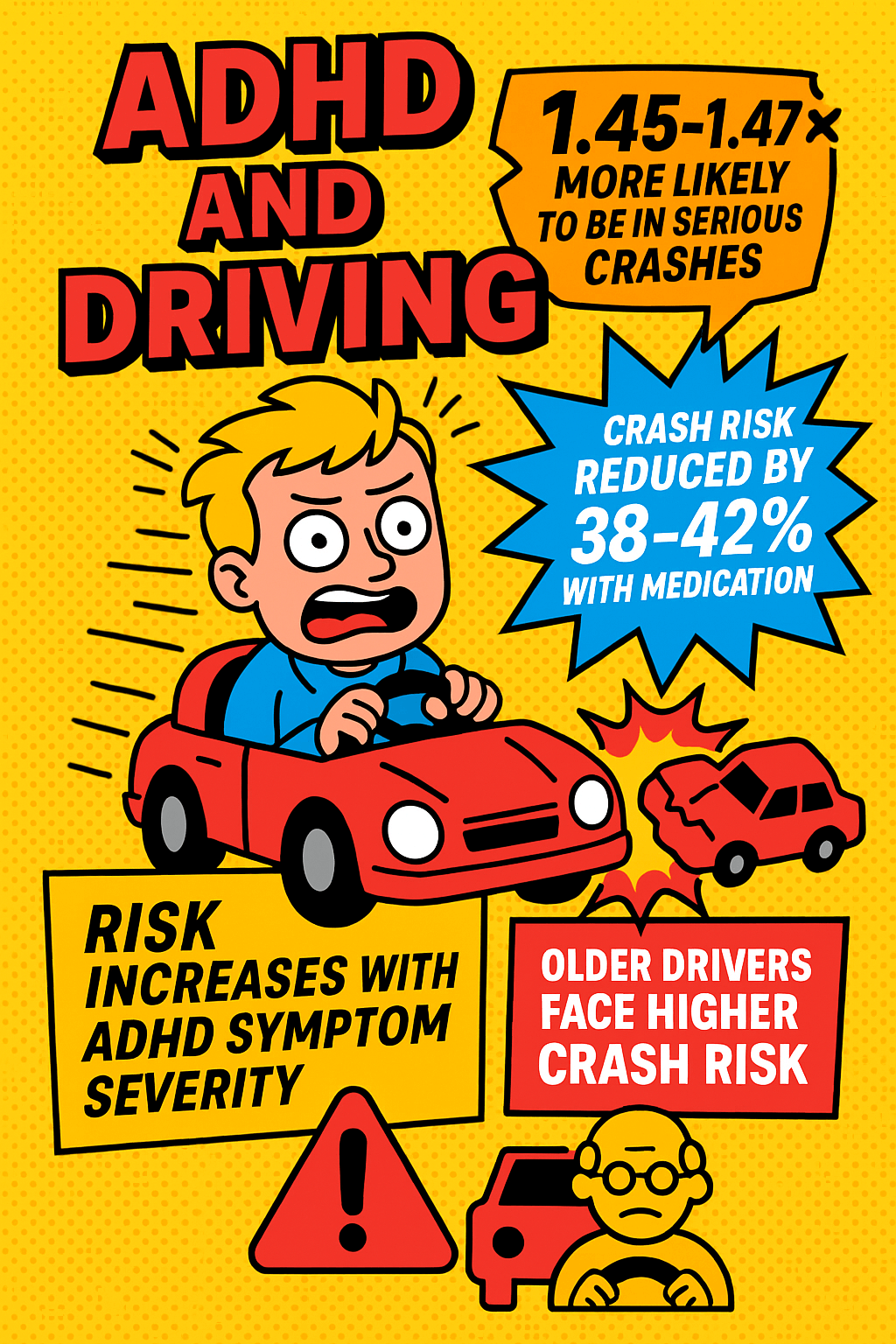ADHD and Driving: Risks, Realities, and How We Can Save Lives
Introduction
Driving is one of the most complex tasks we perform daily. It demands attention, impulse control, quick decision-making, and emotional regulation — the very areas where individuals with Attention-Deficit/Hyperactivity Disorder (ADHD) may face challenges. As a provider who works closely with children, adolescents, and young adults, I know that ADHD does not just affect academics or work. It can directly influence safety behind the wheel, sometimes with life-altering consequences.
Reducing accidents, empowering families, and turning statistics into safer roads for drivers with ADHD
This article combines the latest data from peer-reviewed research, national organizations, and legal perspectives to provide a comprehensive understanding of ADHD and driving — and what we can do to mitigate risks.
The Facts: ADHD and Driving Risks
Research consistently shows that people with ADHD face higher risks on the road:
Higher crash rates: Adults with ADHD are ~1.45–1.47 times more likely to be in serious transport accidents compared to those without ADHD (Chang et al., JAMA Psychiatry, 2014).
Medication reduces risk: When treated with stimulant medications, drivers with ADHD show a 38–42% reduction in crash risk during medicated months (Chang et al., JAMA Psychiatry, 2017).
Symptom severity matters: Each increase in ADHD symptom severity has been linked to a ~5% rise in crash risk (Aduen et al., Archives of Clinical Neuropsychology, 2018).
Older drivers at risk too: In drivers aged 65–79, ADHD doubled the rate of traffic ticket events (22 vs. 10 per million miles) and nearly doubled crash rates compared to peers without ADHD (Liu et al., PMC, 2023).
Overall traffic deaths in the U.S.: Around 40,000 people die each year in motor vehicle crashes (CDC, 2023). If ADHD contributes to even a fraction of these, the impact is significant.
Why Driving is More Dangerous with ADHD
The elevated risk comes from multiple overlapping factors:
Inattention – Missing traffic signals, overlooking hazards, or being slow to react.
Impulsivity – Acting without thinking, sudden lane changes, tailgating, or risky passing.
Hyperactivity/Restlessness – Difficulty staying calm and consistent behind the wheel.
Co-occurring conditions – Anxiety, depression, sleep disorders, or substance use can further worsen driving performance.
Medication status – Untreated ADHD poses the highest risk; appropriately managed ADHD reduces it.
Legal Considerations: What Families Should Know
According to Shamieh Law’s review of ADHD and driving, ADHD can complicate legal responsibility in car accidents:
Liability: ADHD symptoms, like inattention or impulsivity, may contribute to fault in crashes, but ADHD itself is not a legal defense.
Insurance implications: Multiple violations or accidents can increase premiums. Insurers may consider ADHD a risk factor if it leads to repeated traffic issues.
Documentation matters: Maintaining records of diagnosis, treatment adherence, and follow-up care may be important if ADHD is ever questioned in a legal or insurance dispute.
Court perspective: While ADHD can be raised to explain behavior, courts generally focus on whether safe driving practices were followed, not on the diagnosis itself.
This underscores why proper management and documentation of ADHD care is not just a health issue — it can also provide legal protection.
Mitigation Strategies: How to Reduce Risks
The good news is that risks can be significantly reduced with evidence-based interventions:
Diagnosis and Treatment
Early, accurate ADHD diagnosis is essential.
Medication, particularly stimulants, lowers crash risk by up to 40%.
Addressing comorbidities (like sleep issues or anxiety) improves outcomes.
Driver Training and Coaching
Hazard perception training, safe following distances, and structured practice hours help.
Technology-assisted training (like simulators or telemetric feedback) can reinforce safe habits.
Graduated Licensing Policies
Teens with ADHD may benefit from stricter graduated driver licensing (GDL) rules, like limiting night driving or passenger numbers.
Vehicle and Technology Supports
Advanced Driver Assistance Systems (ADAS) like lane-keeping alerts, automatic braking, and collision warnings can serve as safety nets.
Behavioral Strategies
Drive when medication is active.
Avoid driving when tired, upset, or distracted.
Eliminate phone use while driving (apps can block notifications).
Take regular breaks on longer drives.
Practical Tips for Families
Plan driving lessons and test times when ADHD medication is most effective.
Educate teens about risks without stigma — frame it as being proactive, not punitive.
Create structured driving rules at home (no phone use, limit passengers, curfews).
Use apps and technology that promote accountability and feedback.
Stay involved: Parents and guardians should ride along often during the learning phase.
Conclusion
ADHD doesn’t have to mean unsafe driving. Yes, the statistics are sobering: higher crash risks, increased violations, and greater danger for both young and older drivers. But with early diagnosis, proper treatment, behavioral strategies, legal awareness, and family support, much of this risk can be mitigated.
At SHIELD Psychiatry, we believe in empowering young minds and families not only to thrive academically and socially, but also to stay safe in real-world challenges — such as driving. By combining clinical care with education and advocacy, we can help ensure that every journey is a safer one.


